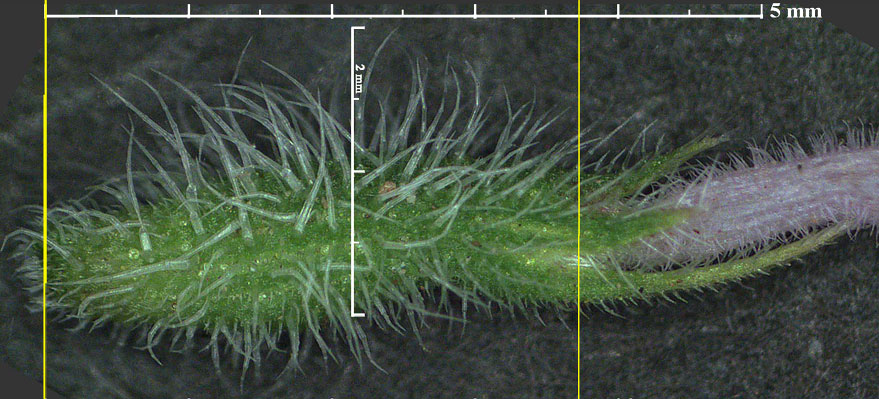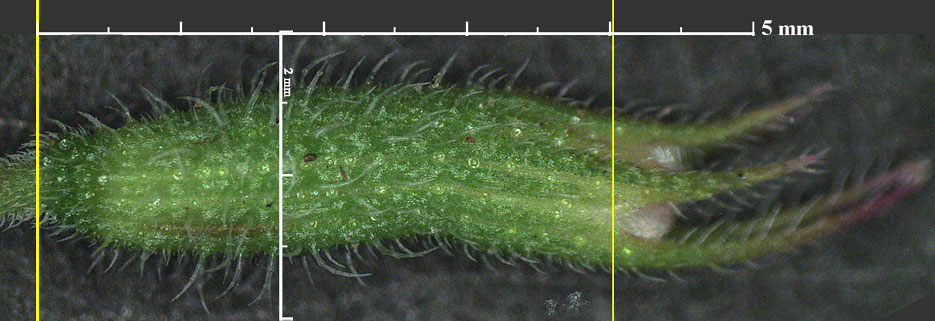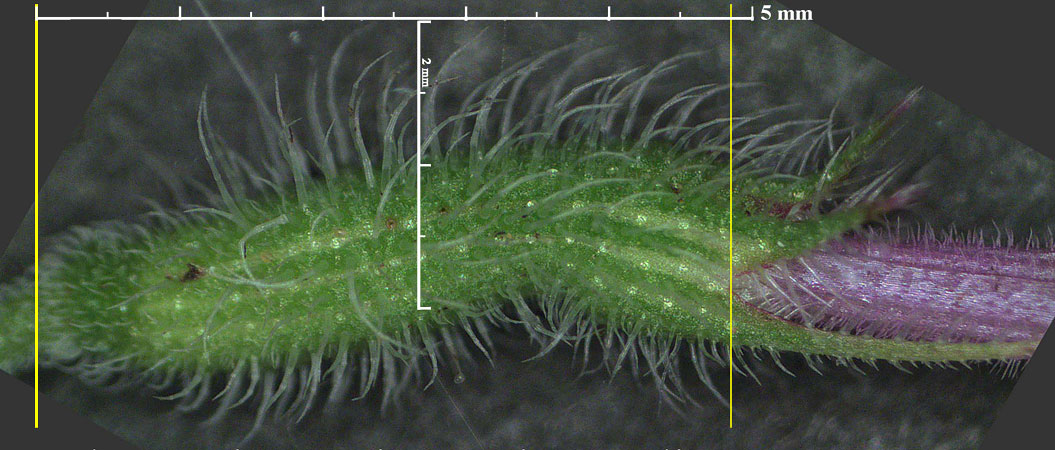Calyx Hair Length Comparison in the Hedeoma drummondii complex
I: First Anthesis
Images below show Hedeoma calyxes at first anthesis, selected as typical from among 34 collections made in late April and early May. (20 of these are presented in a gallery.) Additionally, these images have been selected because their orientation shows any difference in hair length on the upper surface (terminating in the 3 shorter upper teeth)
Yellow lines mark the calyx base and the base of the upper teeth. A vertical scale (2 mm) has been positioned in the area of the longest hairs.
Click on an image for a larger view.
H. reverchonii var. serpyllifoia, N Hays Co., 30 April 2014.
The longest upper surface hairs are spreading, generally exceed 1 mm, those of the lower surface about half as long, exceeding 0.5 mm, and more narrow. On both surfaces the longest hairs are on the center of the calyx, gradually reduced toward the two ends.

H. drummondii, two types:
The difference noted is that the upper teeth of the W Travis calyx are somewhat reflexed, in contrast with the Hays calyx, with teeth clasping the corolla, the typical pattern for H. drummondii. Images from October show both plants with clasping upper teeth. My initial speculation was that the atypical form in the early May Travis plant is an immature feature, the corolla not fully developed. Calyxes from this plant on May 17 with fully developed corollas showed that this is not entirely correct. Three forms were found: (1) reflexed as with the image shown here, (2) less reflexed or reflexed only in the distal half of the upper teeth, & (3) not reflexed. Additional collections on May 17 from the Hays plants had no reflexed upper teeth. Exposure and moisture may have contributed to the difference: the Hays plants were in partial shade & the Travis plant was in full sun; and the only significant spring rainfall (4.2 inches) occurred after the May 6 collections, thus allowing the Travis plants to develop more typically.
The two types show no significant difference in their hair patterns. In contrast with H. r. serpyllifoia, there is no difference between the upper and lower surface, with longest hairs only rarely exceeding 0.5 mm. These are found below the midpoint, gradually reduced toward the teeth.
- W Travis Co., 6 May 2014.

- Central Hays Co., 6 May 2014.

H. reverchonii var. reverchonii, W Travis Co., 6 May 2014.
The length of the calyx body is significantly (ca. 1 mm) longer than with the other taxa, ± 5 mm. The overall hair pattern is similar to H. r. serpyllifoia. The longest upper surface hairs are spreading, generally exceed 1 mm, those of the lower surface about half as long, exceeding 0.5 mm, and more narrow. On both surfaces the longest hairs are on the center of the calyx, with at most very slight reduction toward the teeth.

A hybrid from central Hays Co., assumed to represent H. drummondii × H. reverchonii var. serpyllifoia.
This calyx is very close to that of H. drummondii, although the longest hairs are slightly longer, exceeding 0.6 mm. And similar to the Travis Co. form of H. drummondii, the upper teeth are reflexed — but a calyx image from May 2013, with fully developed corolla, shows them clasping. A collection made on May 17 had changed roughly along the lines for the H. drummondii, with all showing partially reflexed upper teeth, although a less developed calyx had a greater degree of reflexion from the teeth base.

Plant Resources Center Home Page — Flora of Texas
— Hedeoma



